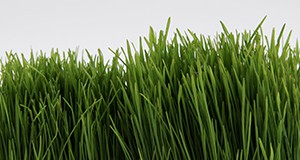Golf course nutrient management programs commonly include application of both nitrogen and potassium. These macronutrients are required by turfgrass in greater quantities than any other element except carbon, hydrogen, and oxygen. This two-page fact sheet explains the Nitrogen to Potassium ratios that are best for golf courses. Written by T.W. Shaddox and J.B. Unruh and published by the Environmental Horticulture Department.
http://edis.ifas.ufl.edu/ep540
Tag: J.Bryan Unruh
Turfgrass Herbicides: Mechanisms of Action and Resistance Management
Herbicides are an effective tool for controling weeds in turfgrass; however, weeds can become resistant to herbicides and create significant problems for turfgrass production. The best way to combat herbicide resistance is to rotate herbicides with different mechanisms of action (MOA) because using herbicides with different MOAs makes it more likely that weeds resistant to one herbicide will encounter an herbicide to which they are not resistant. This 4-page fact sheet focuses on how to create an herbicide program that uses different MOAs to manage resistant weeds. Written by Ramon G. Leon and Bryan Unruh, and published by the UF Department of Agronomy, August 2015.
http://edis.ifas.ufl.edu/ag398
Doveweed (Murdannia nudiflora) Control in Warm-Season Turfgrass Species
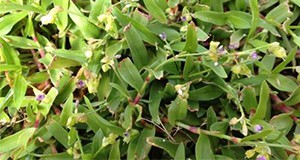 Doveweed is an aggressive, naturalized summer annual weed that rapidly invades warm-season turfgrass species, especially in residential lawns, and few herbicides can effectively control it. Because of these challenges, a well-designed management strategy is necessary for doveweed control. This 4-page fact sheet describes identification, growth requirements, chemical control and cultural practices. Written by Ramon G. Leon and Bryan Unruh, and published by the UF Department of Agronomy, June 2015.
Doveweed is an aggressive, naturalized summer annual weed that rapidly invades warm-season turfgrass species, especially in residential lawns, and few herbicides can effectively control it. Because of these challenges, a well-designed management strategy is necessary for doveweed control. This 4-page fact sheet describes identification, growth requirements, chemical control and cultural practices. Written by Ramon G. Leon and Bryan Unruh, and published by the UF Department of Agronomy, June 2015.
http://edis.ifas.ufl.edu/ag395
Violet Biology and Management in Turf
 Violets (Viola spp.) are diverse winter annuals and perennials. Perennials form rhizomes or long stolons. Many have heart-shaped leaves on long petioles and have a rosette growth habit. Some have linear leaves and others have palmate leaves. Flowers are generally purple, but can be white, pink or yellow. They reproduce by seed or, when produced, rhizomes. This 2-page fact sheet was written by Darcy E. P. Telenko, Barry J. Brecke, Ramon Leon, and J. Bryan Unruh, and published by the UF Department of Environmental Horticulture, December 2013.
Violets (Viola spp.) are diverse winter annuals and perennials. Perennials form rhizomes or long stolons. Many have heart-shaped leaves on long petioles and have a rosette growth habit. Some have linear leaves and others have palmate leaves. Flowers are generally purple, but can be white, pink or yellow. They reproduce by seed or, when produced, rhizomes. This 2-page fact sheet was written by Darcy E. P. Telenko, Barry J. Brecke, Ramon Leon, and J. Bryan Unruh, and published by the UF Department of Environmental Horticulture, December 2013.
http://edis.ifas.ufl.edu/ep496
Spreading Dayflower Biology and Management in Turf
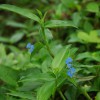 Spreading dayflower (Commelina diffusa) is a succulent annual that produces freely branched smooth stems. Leaves are broadly lance-shaped with closed sheaths. Sheaths are short with a few soft hairs on the upper margin. Flowers have three blue petals in a leaf-like structure open on the margins. Reproduction occurs via seed and stem fragments. This 2-page fact sheet was written by J. Bryan Unruh, Darcy E. P. Telenko, Barry J. Brecke, and Ramon Leon, and published by the UF Department of Environmental Horticulture, December 2013.
Spreading dayflower (Commelina diffusa) is a succulent annual that produces freely branched smooth stems. Leaves are broadly lance-shaped with closed sheaths. Sheaths are short with a few soft hairs on the upper margin. Flowers have three blue petals in a leaf-like structure open on the margins. Reproduction occurs via seed and stem fragments. This 2-page fact sheet was written by J. Bryan Unruh, Darcy E. P. Telenko, Barry J. Brecke, and Ramon Leon, and published by the UF Department of Environmental Horticulture, December 2013.
http://edis.ifas.ufl.edu/ep497
Black Medic Biology and Management in Turf
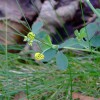 Black medic (Medicago lupulina) is a dark green annual with spreading, prostrate growth. Leaves are alternate with three leaflets on square stems. Leaflets are obovate to elliptic, toothed near the tip, and have a small spur on the tip. Bright yellow flowers are produced in tight, compressed clusters at leaf axils. Reproduction occurs via seed in tightly coiled black seed pods. This 2-page fact sheet was written by Barry J. Brecke, Ramon Leon, J. Bryan Unruh, and Darcy E. P. Telenko, and published by the UF Department of Environmental Horticulture, December 2014.
Black medic (Medicago lupulina) is a dark green annual with spreading, prostrate growth. Leaves are alternate with three leaflets on square stems. Leaflets are obovate to elliptic, toothed near the tip, and have a small spur on the tip. Bright yellow flowers are produced in tight, compressed clusters at leaf axils. Reproduction occurs via seed in tightly coiled black seed pods. This 2-page fact sheet was written by Barry J. Brecke, Ramon Leon, J. Bryan Unruh, and Darcy E. P. Telenko, and published by the UF Department of Environmental Horticulture, December 2014.
http://edis.ifas.ufl.edu/ep494
Sedge Biology and Management in Turf
 Members of the sedge family have leaves that are composed of a blade, sheath, and ligule. The leaf sheath is closed and the ligule is often absent, and when present is tiny. Stem structure is often triangular.This 3-page fact sheet was written by D. E. P. Telenko, Ramon Leon, J. Bryan Unruh, and B. J. Brecke, and published by the UF Department of Environmental Horticulture, December 2014.
Members of the sedge family have leaves that are composed of a blade, sheath, and ligule. The leaf sheath is closed and the ligule is often absent, and when present is tiny. Stem structure is often triangular.This 3-page fact sheet was written by D. E. P. Telenko, Ramon Leon, J. Bryan Unruh, and B. J. Brecke, and published by the UF Department of Environmental Horticulture, December 2014.
http://edis.ifas.ufl.edu/ep492
Old World Diamond-Flower Biology and Management in Turf
 Old world diamond-flower is a smooth, spreading summer annual. It has branched stems with opposite, narrow leaves. Flowers are white, usually with two or more on long stalks extending from the tip of a common long stalk. Flowers occur from midsummer until frost. Reproduction occurs by seed. Found in moist areas, especially areas that have been disturbed. This 2-page fact sheet was written by Darcy E. P. Telenko, Barry J. Brecke, Ramon Leon, and J. Bryan Unruh, and published by the UF Department of Environmental Horticulture, December 2013.
Old world diamond-flower is a smooth, spreading summer annual. It has branched stems with opposite, narrow leaves. Flowers are white, usually with two or more on long stalks extending from the tip of a common long stalk. Flowers occur from midsummer until frost. Reproduction occurs by seed. Found in moist areas, especially areas that have been disturbed. This 2-page fact sheet was written by Darcy E. P. Telenko, Barry J. Brecke, Ramon Leon, and J. Bryan Unruh, and published by the UF Department of Environmental Horticulture, December 2013.
http://edis.ifas.ufl.edu/ep493
Erect and Prostrate Spurge Biology and Management in Turf
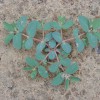 Erect and prostrate spurges are erect or upright annuals with branched stems. Leaves are opposite and not equal. Stems produce “milky sap.” A large number of spurge species occur in Florida. Reproduction occurs via seed. This 2-page fact sheet was written by J. Bryan Unruh, Darcy E. P. Telenko, Barry J. Brecke, and Ramon Leon, and published by the UF Department of Environmental Horticulture, December 2013.
Erect and prostrate spurges are erect or upright annuals with branched stems. Leaves are opposite and not equal. Stems produce “milky sap.” A large number of spurge species occur in Florida. Reproduction occurs via seed. This 2-page fact sheet was written by J. Bryan Unruh, Darcy E. P. Telenko, Barry J. Brecke, and Ramon Leon, and published by the UF Department of Environmental Horticulture, December 2013.
http://edis.ifas.ufl.edu/ep495
Weed Management Guide for Florida Lawns
 Weeds can be defined as unwanted plants or plants growing out of place. Proper identification and some understanding of how and why weeds are present in a lawn are important when selecting the best control strategy. Knowing whether or not weeds were previously present in a particular area also helps homeowners prepare control measures in the future. Weed control should be a carefully planned and coordinated program. This 8-page fact sheet was written by J.Bryan Unruh, Ramon G. Leon, Barry J. Brecke, and Laurie E. Trenholm, and published by the UF Department of Environmental Horticulture, July 2013.
Weeds can be defined as unwanted plants or plants growing out of place. Proper identification and some understanding of how and why weeds are present in a lawn are important when selecting the best control strategy. Knowing whether or not weeds were previously present in a particular area also helps homeowners prepare control measures in the future. Weed control should be a carefully planned and coordinated program. This 8-page fact sheet was written by J.Bryan Unruh, Ramon G. Leon, Barry J. Brecke, and Laurie E. Trenholm, and published by the UF Department of Environmental Horticulture, July 2013.
http://edis.ifas.ufl.edu/ep141
Watering Your Florida Lawn (ENH9/LH025)
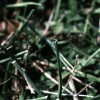 Irrigation is one of the most important cultural practices that we do for our lawns. Since water is a limited resource and is vital to the health of your lawn, it is very important that watering be done correctly. This 3-page fact sheet was written by L. E. Trenholm, J. B. Unruh, and J. L. Cisar, and published by the UF Department of Environmental Horticulture, April 2013.
Irrigation is one of the most important cultural practices that we do for our lawns. Since water is a limited resource and is vital to the health of your lawn, it is very important that watering be done correctly. This 3-page fact sheet was written by L. E. Trenholm, J. B. Unruh, and J. L. Cisar, and published by the UF Department of Environmental Horticulture, April 2013.
http://edis.ifas.ufl.edu/lh025
ENH14/EP098 Overseeding Florida Lawns for Winter Color
Revised! ENH14, a 4-page illustrated fact sheet by L.E. Trenholm and J. Bryan Unruh, describes this practice used to provide green winter turf color for Florida lawns — selecting rye grasses, seedbed preparation, maintenance, and transitioning back to permanent grass. Published by UF Department of Environmental Horticulture, December 2010.
http://edis.ifas.ufl.edu/ep098
ENH1174/EP435 The Lawn Fertilizer Toolbox
ENH1174, a 3-page fact sheet by Laurie E. Trenholm, Jason K. Kruse, and J. Bryan Unruh, describes the nutrients in fertilizer that are most important for keeping turfgrass healthy and when to fertilize. Published by the UF Department of Environmental Horticulture, October 2010.
http://edis.ifas.ufl.edu/ep435
ENH860/EP110 Fertilization and Irrigation Needs for Florida Lawns and Landscapes
Revised! ENH860, a 6-page fact sheet by L.E. Trenholm, E.F. Gilman, G. Denny and J. Bryan Unruh, outlines environmentally friendly approaches to fertilizing and irrigating Florida lawns and landscapes. Published by the UF Department of Environmental Horticulture, December 2009.
http://edis.ifas.ufl.edu/ep110
Weed Biology and Management in Turf series
This series of 1-2 page illustrated fact sheets by J. Bryan Unruh, Darcy E. Partridge-Telenko, and Barry J. Brecke highlight key facts about each weed, and include herbicide options for each variety of Florida turfgrass. Published by the UF Department of Environmental Horticulture, June 2009.
- ENH1124/EP385 Yellow Woodsorrel (Oxalis) Biology and Management in Turf
- ENH1125/EP386 Virginia Buttonweed Biology and Management in Turf
- ENH1126/EP387 Torpedograss Biology and Management in Turf
- ENH1127/EP388 Florida Betony Biology and Management in Turf
- ENH1128/EP389 Pennywort (Dollarweed) Biology and Management
- ENH1131/EP392 Annual Bluegrass Biology and Management in Turf
- ENH1132/EP393 Tropical Signalgrass Biology and Management in Turf
- ENH1133/EP394 Goosegrass Biology and Management in Turf
- ENH1134/EP395 Crabgrass Biology and Management in Turf
http://edis.ifas.ufl.edu/TOPIC_SERIES_Weed_Biology_and_Management_in_Turf
SL283/SS496 Unintended Consequences Associated with Certain Urban Fertilizer Ordinances
SL-283, an 11-page illustrated fact sheet by George Hochmuth, Terril Nell, Jerry Sartain, Bryan Unruh, Michael Dukes, Chris Martinez, Laurie Trenholm, and John Cisar, discusses the research behind turfgrass growth, biology, and ecology, and soil nutrient cycling in the lawn. The unintended consequences of fertilizer ordinance restricted periods are presented to open dialogue among the stakeholders in the ordinance issue and to ensure that all information is presented to completely inform the policy-making process. Includes references. Published by the UF Department of Soil and Water Sciences, March 2009.
http://edis.ifas.ufl.edu/SS496
ENH962/EP221 Figuring out Fertilizer for the Home Lawn
Revised! ENH-962, a 4-page illustrated fact sheet by L.E. Trenholm and J.B. Unruh, help homeowners understand how to properly handle fertilizers and apply the correct amounts of fertilizer at the appropriate times. Published by the UF Department of Environmental Horticulture, February 2009.
http://edis.ifas.ufl.edu/EP221
ENH63/EP054 Let Your Lawn Tell You When to Water
ENH-63, a 3-page illustrated fact sheet by L.E. Trenholm and J. Bryan Unruh, helps homeowners avoid overwatering their lawns by operating irrigation systems only when the lawn shows signs of drought stress. Published by the UF Department of Environmental Horticulture, November 2008.
http://edis.ifas.ufl.edu/EP054
ENH884/EP141 Weed Management in Home Lawns
Revised! ENH-884, a 9-page fact sheet by J.Bryan Unruh, Barry Brecke, Laurie E. Trenholm, provides homeowners with information to carry out a carefully planned and coordinated weed control program for their lawns. Describes types of weeds, proper lawn management, weed biology and control, weed control prior to turf establishment and in established turf, and pesticide application procedures. Published by the UF Department of Environmental Horticulture, April 2008.

